HHS/ACF/OPRE Head Start Classroom-based Approaches and Resources for Emotion and Social skill promotion (CARES) project: Impact and Implementation Studies- Teacher Report on Individual Children
HHS/ACF/OPRE Head Start Classroom-based Approaches and Resources for Emotion and Social skill promotion (CARES) project: Impact and Implementation Studies
OMB CARES 2nd Package_Appendix A.3_Teacher Report on Children
HHS/ACF/OPRE Head Start Classroom-based Approaches and Resources for Emotion and Social skill promotion (CARES) project: Impact and Implementation Studies- Teacher Report on Individual Children
OMB: 0970-0364
Appendix A.3: Head Start CARES Teacher Report on Individual Children
 Updated
January 27, 2009
Updated
January 27, 2009
TEACHER REPORT ON INDIVIDUAL CHILDREN
FOR HEAD START CARES
BASELINE AND FOLLOW-UP MEASURES
TABLE OF CONTENTS
3 Section A – Social Skills Rating Scale (SSRS)- Social Skills Scale & Academic Competence
Scale (Kindergarten follow-up only)
Gresham & Elliot (1990)
5 Section B – Student-Teacher Relationship Scale (STRS)
Pianta (2001)
6 Section C – Behavior Problems Index (BPI)
Zill & Peterson (1986)
8 Section D – Cooper Farran Behavioral Ratings Scale (CFBRS)
Cooper & Farran (1991)
12 Section E – Academic Rating Scale (ARS)
Perry & Meisels (1996)
15 Section F – Parent-Teacher Involvement Questionnaire (teacher version)
Bierman, Greenberg & CPPRG (1996)
Section A – Social Skills Rating Scale (SSRS, Social Skills Scale Teacher –Preschool version & Academic Competence Scale Teacher- Elementary version)
The student will…
Follow the teacher’s directions
Make friends easily
Appropriately tell the teacher when he or she thinks unfair treatment has been received.
Respond appropriately to teasing by peers.
Appropriately question rules that may be unfair.
Attempt classroom tasks before asking for the teacher’s help.
Control temper in conflict situations with adults.
Give compliments to peers.
Participate in games or group activities
Produce correct schoolwork
Help the teacher without being asked
Introduce himself or herself to new people without being told
Accept peers’ ideas for group activities
Cooperate with peers without prompting
Wait her or his turn in games or other activities
Use time appropriately while waiting for the teacher’s help
Say nice things about himself or herself when appropriate
Use free time in an acceptable way
Acknowledge compliments or praise from peers
Control her or his temper in conflict situations with peers
Follow rules when playing games with others
Finish class assignments within specified time limits
Compromise in conflict situations by changing own ideas to reach agreement
Initiate conversations with peers
Invite others to join in activities
Receive criticism well
Put work materials or school property away
Respond appropriately to peer pressure
Join an ongoing activities or group without being told to do so
Volunteer to help peers with classroom tasks
Each question is answered on a three-point scale: 0 – Never, 1 – Sometimes, 2 – Very Often
(Only at Kindergarten follow-up) The next nine items require your judgments of this student’s academic or learning behaviors as observed in your classroom. Compare the student with other children who are in the same classroom.
Compared with other children in my classroom, the overall academic performance is…
In reading, how does this child compare with other students?
In mathematics, how does this child compare with other students?
In terms of grade-level expectations, this child’s skills in reading are…
In terms of grade-level expectations, this child’s skills in mathematics are…
This child’s overall motivation to succeed academically is…
This child’s parental encouragement to succeed academically is…
Compared with other children in the classroom, this child’s intellectual functioning is…
Compared with other children in the classroom, this child’s overall classroom behavior is…
All items are rated using a five-point scale. The number 1 indicates the lower or least favorable performance, placing the student in the lowest 10% of the class. The number 5 indicates the highest or most favorable performance, placing the student in the highest 10% compared with other students in the classroom.
Section B – Student-Teacher Relationship Scale (STRS)
Please reflect on the degree to which each of the following statements currently applies to your relationship with this child. Using the scale, mark the appropriate number for each item.
Definitely does not apply 1 |
Not really 2 |
Neutral, not sure 3 |
Applies somewhat 4 |
Definitely applies 5 |
1. I share an affectionate, warm relationship with this child. 1 2 3 4 5
2. This child and I always seem to be struggling with each other. 1 2 3 4 5
3. If upset, this child will seek comfort from me. 1 2 3 4 5
4. This child is uncomfortable with physical affection or touch from me. 1 2 3 4 5
5. This child values his/her relationship with me. 1 2 3 4 5
6. When I praise this child, he/she beams with pride. 1 2 3 4 5
7. This child spontaneously shares information about himself/herself. 1 2 3 4 5
8. This child easily becomes angry with me. 1 2 3 4 5
9. It is easy to be in tune with what this child is feeling. 1 2 3 4 5
10. This child remains angry or is resistant after being disciplined. 1 2 3 4 5
11. Dealing with this child drains my energy. 1 2 3 4 5
12. When this child is in a bad mood, I know we’re in for a
long and difficult day. 1 2 3 4 5
13. This child’s feelings toward me can be unpredictable
or can change suddenly. 1 2 3 4 5
14. This child is sneaky or manipulative with me. 1 2 3 4 5
15. This child openly shares his/her feelings and experiences with me. 1 2 3 4 5
Section C – Behavior Problems Index (BPI)
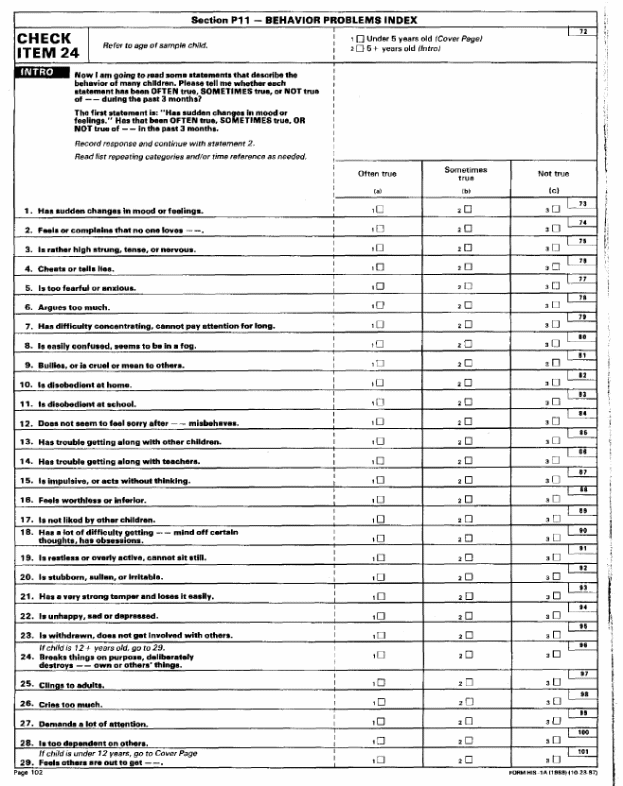
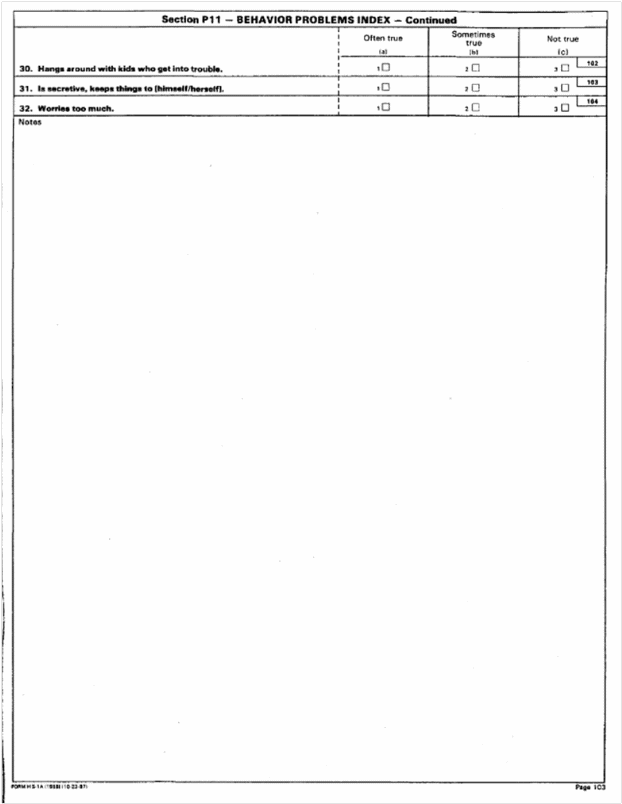
Section D – Cooper Farran Behavioral Ratings Scale (CFBRS)
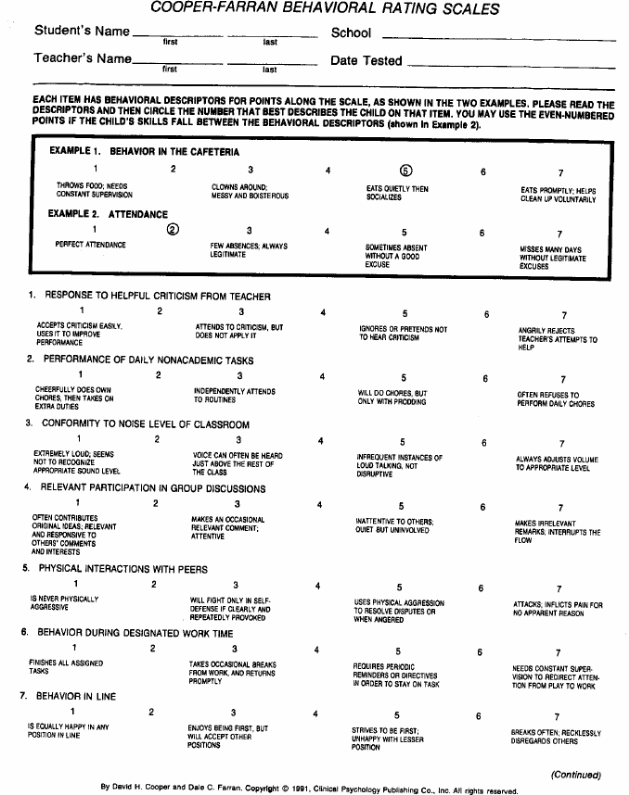

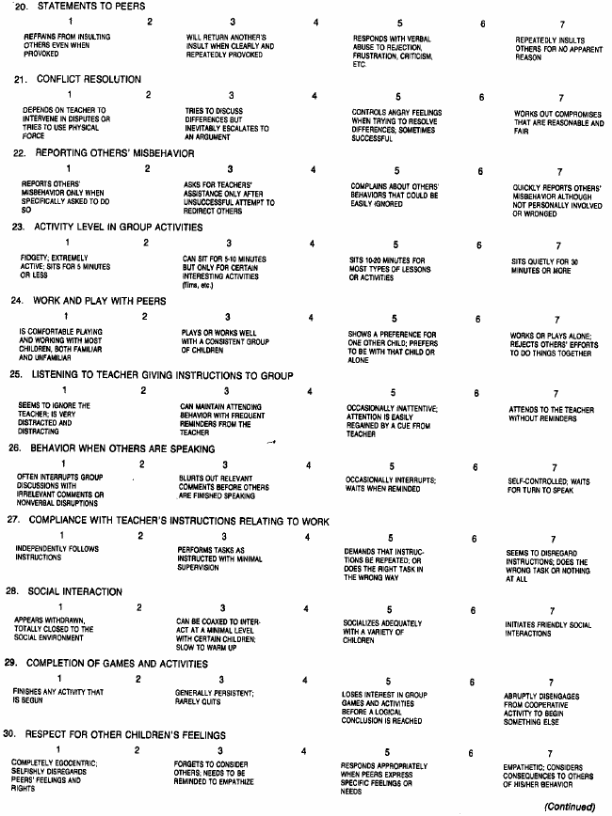
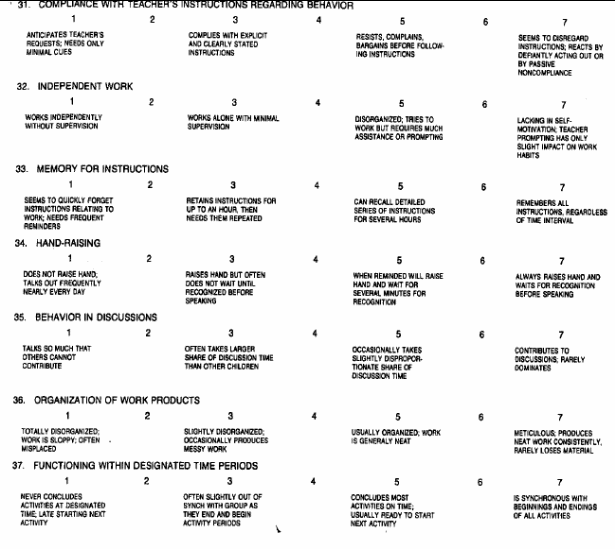
Section E – Academic Rating Scale (ARS)
Section 1: Language and Literacy
This Child…
|
CIRCLE ONE FOR EACH ITEM |
|||||
Not yet |
Beginning |
In progress |
Intermediate |
Proficient |
Not applicable |
|
|
1 |
2 |
3 |
4 |
5 |
N/A |
|
1 |
2 |
3 |
4 |
5 |
N/A |
|
1 |
2 |
3 |
4 |
5 |
N/A |
|
1 |
2 |
3 |
4 |
5 |
N/A |
|
1 |
2 |
3 |
4 |
5 |
N/A |
|
1 |
2 |
3 |
4 |
5 |
N/A |
|
1 |
2 |
3 |
4 |
5 |
N/A |
|
1 |
2 |
3 |
4 |
5 |
N/A |
|
1 |
2 |
3 |
4 |
5 |
N/A |
Section 2: General Knowledge
This Child…
|
CIRCLE ONE FOR EACH ITEM |
|||||
Not yet |
Beginning |
In progress |
Intermediate |
Proficient |
Not applicable |
|
|
1 |
2 |
3 |
4 |
5 |
N/A |
|
1 |
2 |
3 |
4 |
5 |
N/A |
|
1 |
2 |
3 |
4 |
5 |
N/A |
|
1 |
2 |
3 |
4 |
5 |
N/A |
|
1 |
2 |
3 |
4 |
5 |
N/A |
Section 3: Mathematical Knowledge
This Child…
|
CIRCLE ONE FOR EACH ITEM |
|||||
Not yet |
Beginning |
In progress |
Intermediate |
Proficient |
Not applicable |
|
|
1 |
2 |
3 |
4 |
5 |
N/A |
|
1 |
2 |
3 |
4 |
5 |
N/A |
|
1 |
2 |
3 |
4 |
5 |
N/A |
|
1 |
2 |
3 |
4 |
5 |
N/A |
|
1 |
2 |
3 |
4 |
5 |
N/A |
|
1 |
2 |
3 |
4 |
5 |
N/A |
|
1 |
2 |
3 |
4 |
5 |
N/A |
Section F – Parent-Teacher Involvement Questionnaire (teacher version)
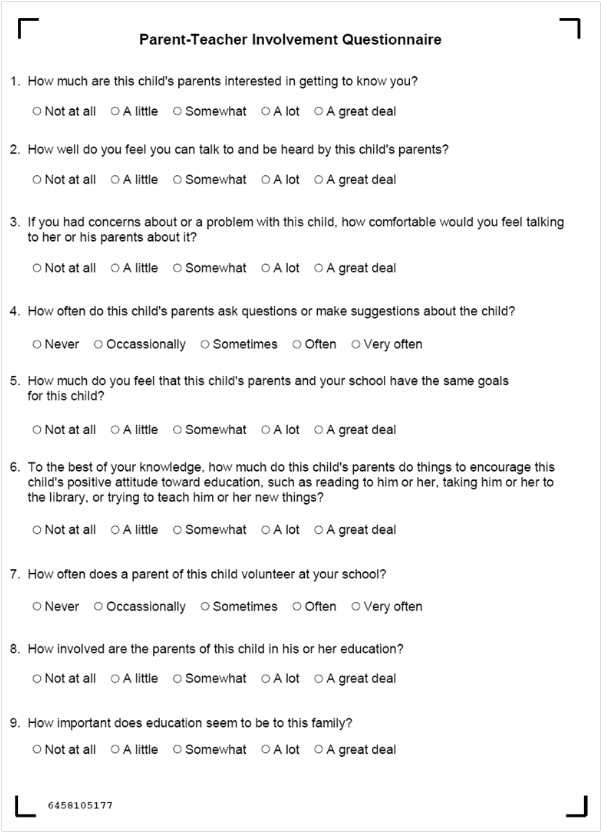
| File Type | application/msword |
| Author | Matthew Kim |
| Last Modified By | Ximena Portilla |
| File Modified | 2009-02-02 |
| File Created | 2008-12-12 |
© 2026 OMB.report | Privacy Policy